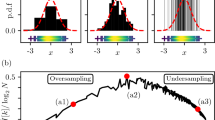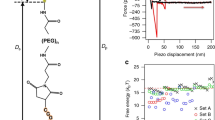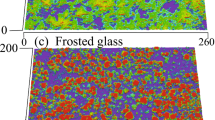Abstract
TOPOGRAPHY is often considered as a narrow bandwidth of features covering the form or shape of the surface. After detailed study of many measurements we consider that as well as the possibility of a dominant range of features there is always an underlying random structure where undulations in surface height continue over as broad a bandwidth as the surface size will allow. We consider this a result of many physical effects each confined to a specific waveband but no band being dominant. We invoke the central limit theorem and show through Gaussian statistics that the variance of the height distribution of such a structure is linearly related to the length of sample involved. In another form, the power spectral density, this relationship is shown to agree well with measurements of structures taken over many scales of size, and from throughout the physical universe.
This is a preview of subscription content, access via your institution
Access options
Subscribe to this journal
Receive 51 print issues and online access
$199.00 per year
only $3.90 per issue
Buy this article
- Purchase on Springer Link
- Instant access to full article PDF
Prices may be subject to local taxes which are calculated during checkout
Similar content being viewed by others
References
Van Deusen, B. D. A Statistical Technique for the Dynamic Analysis of Vehicles Traversing Rough Yielding and Non-yielding Surfaces (NASA Rep. No. CR-659, 1967).
Thomas, T. R. & Sayles, R. S. Trans. Am. Soc. mech. Engrs, Paper 76-WA/ Prod-23 (1976).
Thomas, T. R. & Sayles, R. S. Proc. I. Mech. E., Tribology 1976 Conf., University of Durham (1976).
Gray, G. G. & Johnson, K. L. J. Sound Vibrat. 22, 323–342 (1972).
Whitehouse, D. J. & Archad, J. F. Proc. R. Soc. A316, 97–121 (1970).
Nayak, P. R. Trans. Am. Soc. mech. Engr. J. Lub. Tech. 93F, 398–407 (1971).
Thomas, T. R. & Sayles, R. S. Prog. Astronautics Aeronautics 39, 3–20 (1975).
Sayles, R. S. & Thomas, T. R. Wear 42, 263–276 (1977).
Wiener, N. Nonlinear problems in random theory (MIT Press, Cambridge Massachusetts, 1958).
Papoulis, A. Probability, Random Variables, and Stochastic Processes (McGraw-Hill, New York, 1965).
Dodds, C. J. & Robson, J. D. J. Sound and Vibrat. 31, 175–183 (1973).
Rozema, W. NASA Interagency report: Astrogeology 12. Purchase Order No. W-12, 388 (1968).
Jaeger, R. M. & Schurling, D. J. J. geophys. Res. 71, (8), 2023 (1966).
Morris, G. J. & Stickle, J. W. NASA Rep. No. TN D-510 (1960).
Bogdanoff, J. L., Cote, L. J. & Kozin, F. J. Terramechanics 2 (3), 17–27 (1965).
Houbolt, J. C. Proc. ASCE, J. Air Transport Div. 87, 11–31 (1961).
Cicero, M. T. Att. 1. 16. 18 (c. 50 BC).
Author information
Authors and Affiliations
Rights and permissions
About this article
Cite this article
SAYLES, R., THOMAS, T. Surface topography as a nonstationary random process. Nature 271, 431–434 (1978). https://doi.org/10.1038/271431a0
Received:
Accepted:
Issue Date:
DOI: https://doi.org/10.1038/271431a0
This article is cited by
-
Surface roughness characterization using representative elementary area (REA) analysis
Scientific Reports (2024)
-
Modeling and analysis for material removal and surface roughness in fluid jet polishing of optical glass
Friction (2024)
-
Tangential contact stiffness modeling between fractal rough surfaces with experimental validation
Archive of Applied Mechanics (2024)
-
Surface Topography in Peripheral Milling of Ti-6Al-4V: Multi-scale Evaluation and Fractal Analysis
Journal of Materials Engineering and Performance (2024)
-
Coupling failure dynamics of tooth surface morphology and wear based on fractal theory
Nonlinear Dynamics (2024)
Comments
By submitting a comment you agree to abide by our Terms and Community Guidelines. If you find something abusive or that does not comply with our terms or guidelines please flag it as inappropriate.



